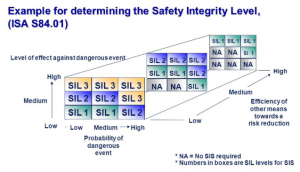QUESTIONS AND ANSWERS FLOW_INSTRUMENTATION
A factor that influences measurement accuracy in magnetic flow meters is:
- Excessive fluid
- Signal distortion
- Temperature fluctuations
- Solids in the fluid
What does the magnetic flowmeter measure?
- Fluid velocity through the meter
- Density of the process fluid
- Specific gravity of the fluid
- Density, viscosity and specific gravity of the material
What is the relationship of voltage to the magnetic field and the velocity of the conductor?
- Voltage is inversely related to the magnetic field intensity and the conductor velocity
- Voltage is directly proportional to the magnetic field intensity and the conductor velocity
- Voltage is proportional to the magnetic field intensity only
- Voltage is proportional to the conductor velocity only
The best types of material to be used in the metering section should be:
- Metal
- Magnetic
- Nonmagnetic
- Nonporous
What name is given to the straight length of the pipe where the process fluid passes through the magnetic field?
- Electrode
- Conductor
- Faraday’s field
- Metering section
What type of problem is associated with using a magnetic flow meter?
- Signal distortion caused by noise
- Relatively high thermal conductivity
- Fluctuating heat capacity
- Sound waves or vibrations
What is a disadvantage associated with a magnetic flow meter?
- It can only measure specific Reynolds number profiles
- It can only be used to measure flow of conductive liquids
- It can only be used with low viscosity fluids
- You must shut down the process to use a magnetic flowmeter
Which of the following is compatible with a magnetic flow meter?
- Gas applications
- Ultrasonic systems
- Electronic control systems
- Flow measurement applications with low velocity fluid
A factor that has the largest influence on measurement accuracy in magnetic flow meters is:
- Slurries in the process fluid
- Variations in density
- The Reynolds number
- Coating of the electrodes
The Coriolis force is the result of:
- Volumetric flow rate
- Specific gravity
- Density of liquid
- Acceleration acting on a mass
Define mass.
- Mass is a measure of the quantity of matter
- Mass is a measure of the proximity of the molecules of a substance
- Mass is a measure of the density of a fluid
- Mass is a measure of how rapidly a substance flows
Which property has an affect on calculating the true mass flow rate of a substance?
- Viscosity
- Density
- Reynolds number
- Velocity
In a mass flow meter, what is the relationship between the sensing element and mass flow rate?
- Reaction of the sensing element is dependent upon the composition of the fluid
- The velocity and the density of the mass flow rate is proportional to the sensing element
- Reaction of a sensing element is proportional to the mass flow rate
- The mass flow rate must be a measure of the Reynold’s number profile
A factor that affects the measurement accuracy of mass flow rate is:
- Temperature of the process fluid
- Slurries in the process fluid
- The Reynolds number
- Variations in density






